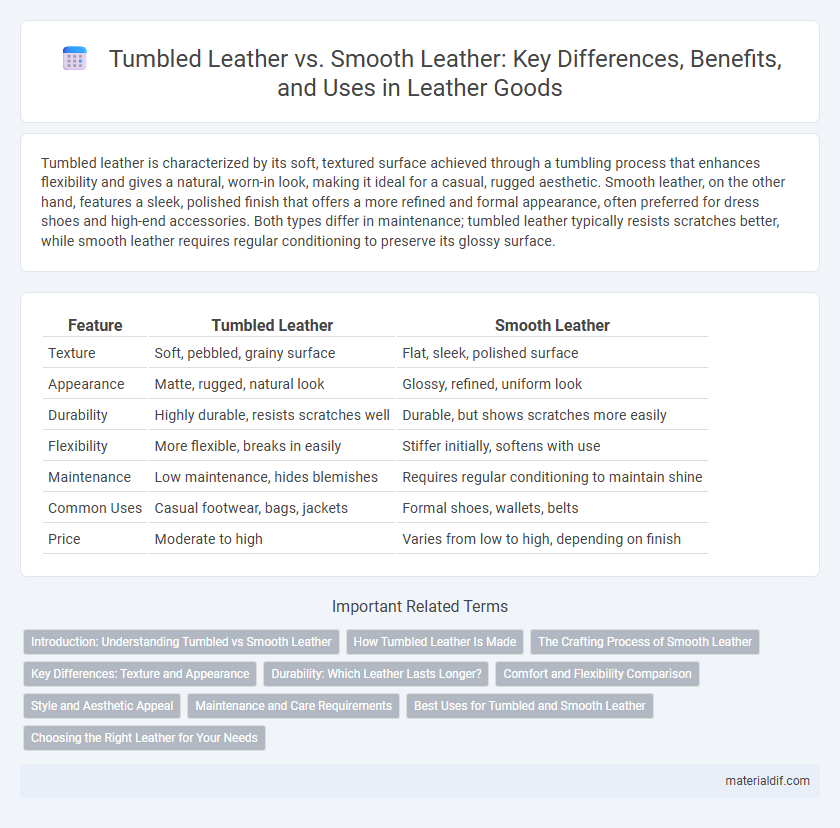Tumbled leather is characterized by its soft, textured surface achieved through a tumbling process that enhances flexibility and gives a natural, worn-in look, making it ideal for a casual, rugged aesthetic. Smooth leather, on the other hand, features a sleek, polished finish that offers a more refined and formal appearance, often preferred for dress shoes and high-end accessories. Both types differ in maintenance; tumbled leather typically resists scratches better, while smooth leather requires regular conditioning to preserve its glossy surface.
Table of Comparison
| Feature | Tumbled Leather | Smooth Leather |
|---|---|---|
| Texture | Soft, pebbled, grainy surface | Flat, sleek, polished surface |
| Appearance | Matte, rugged, natural look | Glossy, refined, uniform look |
| Durability | Highly durable, resists scratches well | Durable, but shows scratches more easily |
| Flexibility | More flexible, breaks in easily | Stiffer initially, softens with use |
| Maintenance | Low maintenance, hides blemishes | Requires regular conditioning to maintain shine |
| Common Uses | Casual footwear, bags, jackets | Formal shoes, wallets, belts |
| Price | Moderate to high | Varies from low to high, depending on finish |
Introduction: Understanding Tumbled vs Smooth Leather
Tumbled leather features a textured, pebble-like surface achieved through a tumbling process that enhances softness and flexibility, making it ideal for durable, casual accessories. Smooth leather, characterized by its polished, sleek finish, offers a more formal aesthetic with greater resistance to stains and easier cleaning. Understanding these differences helps in selecting the appropriate leather type for specific applications in fashion and upholstery.
How Tumbled Leather Is Made
Tumbled leather is produced through a mechanical tumbling process that softens and enhances the texture of the hide, creating a pliable and naturally distressed finish. Unlike smooth leather, which undergoes minimal surface alteration for a sleek, polished appearance, tumbled leather is placed in large drums to intensify grain texture and increase suppleness. This method preserves the hide's natural markings and grains, resulting in durable, flexible leather with a rich, worn-in look preferred for high-quality footwear and accessories.
The Crafting Process of Smooth Leather
The crafting process of smooth leather involves carefully tanning the hide to preserve its natural surface, followed by precise sanding and buffing to remove imperfections and create a sleek, uniform texture. Unlike tumbled leather, which is mechanically softened to produce a pliable, textured finish, smooth leather maintains its firm structure and refined appearance through minimal mechanical treatment. This meticulous process ensures durability and a polished look, making smooth leather a preferred choice for luxury goods and formal accessories.
Key Differences: Texture and Appearance
Tumbled leather features a distinctive pebbled texture created through a tumbling process, giving it a more rugged and natural appearance compared to smooth leather's sleek and polished surface. The texture of tumbled leather enhances its durability and resistance to scratches, while smooth leather is often chosen for its refined, glossy look and uniform finish. These key differences influence both the aesthetic appeal and maintenance requirements of leather goods made from each type.
Durability: Which Leather Lasts Longer?
Tumbled leather features a textured, grainy surface that naturally resists scratches and hides wear, making it highly durable for everyday use. Smooth leather, while elegant and sleek, tends to show scuffs and marks more readily but can be treated with protective finishes to enhance longevity. Overall, tumbled leather generally lasts longer under regular wear due to its robust grain structure and ability to conceal imperfections.
Comfort and Flexibility Comparison
Tumbled leather features a textured surface created by tumbling hides in a drum, enhancing softness and flexibility compared to smooth leather. This process breaks down fibers, resulting in a more pliable material that molds comfortably to the wearer's shape. Smooth leather, while sleek and polished, generally offers less initial flexibility and requires longer break-in periods for optimal comfort.
Style and Aesthetic Appeal
Tumbled leather features a textured, pebbled surface that provides a rugged, vintage aesthetic ideal for casual and rustic styles. Smooth leather displays a sleek, polished finish offering a refined, elegant appearance suited for formal and sophisticated designs. The choice between tumbled and smooth leather directly influences the overall aesthetic, balancing durability with visual appeal based on the desired fashion statement.
Maintenance and Care Requirements
Tumbled leather, characterized by its soft, textured surface, requires regular conditioning to maintain its suppleness and prevent drying or cracking, making it more resilient to scratches compared to smooth leather. Smooth leather demands careful cleaning with mild soaps or leather-specific products and frequent moisturizing to preserve its sleek appearance and prevent surface blemishes. Both types benefit from protection against excessive moisture and direct sunlight, but tumbled leather generally tolerates wear and requires less frequent specialized care.
Best Uses for Tumbled and Smooth Leather
Tumbled leather, known for its soft texture and natural grain, excels in casual apparel, handbags, and accessories that benefit from a relaxed, worn-in feel and durable flexibility. Smooth leather's sleek, polished surface is ideal for formal shoes, jackets, and luxury goods requiring a refined appearance and easy maintenance. Choosing tumbled leather enhances comfort and rugged style, while smooth leather offers sophistication and a crisp aesthetic for professional or elegant settings.
Choosing the Right Leather for Your Needs
Tumbled leather features a textured, pebble-like surface created through a tumbling process, making it more durable and resistant to scratches, ideal for heavy-use items like bags and shoes. Smooth leather offers a sleek, polished finish with a refined appearance, perfect for formal accessories and furniture that prioritize aesthetics over ruggedness. Selecting the right leather depends on the balance between durability needs and desired appearance, with tumbled leather suited for longevity and maintenance, while smooth leather emphasizes elegance and a luxurious look.
Tumbled Leather vs Smooth Leather Infographic

 materialdif.com
materialdif.com